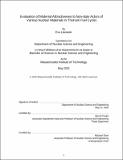| dc.contributor.advisor | Benoit Forget. | en_US |
| dc.contributor.author | Lisowski, Eva. | en_US |
| dc.contributor.other | Massachusetts Institute of Technology. Department of Nuclear Science and Engineering. | en_US |
| dc.date.accessioned | 2020-09-15T21:51:21Z | |
| dc.date.available | 2020-09-15T21:51:21Z | |
| dc.date.copyright | 2020 | en_US |
| dc.date.issued | 2020 | en_US |
| dc.identifier.uri | https://hdl.handle.net/1721.1/127306 | |
| dc.description | Thesis: S.B., Massachusetts Institute of Technology, Department of Nuclear Science and Engineering, May, 2020 | en_US |
| dc.description | Cataloged from the official PDF of thesis. | en_US |
| dc.description | Includes bibliographical references (pages 42-43). | en_US |
| dc.description.abstract | Thorium-based fuel cycles for advanced nuclear reactors have been explored to utilize thorium resources in nations where uranium is scarce, increase fissile material utilization, and enhance proliferation resistance. As a stepping stone, thorium-based fuels have been paired with pressure tube heavy water reactors because of their high neutron economy and online refueling capability. However, thorium fuel cycles have raised proliferation concerns regarding the presence of U-233 following the irradiation of fuel bundles. The presence of Pa-233, which decays into pure U-233, and the creation of Pu-239 due to the neutron capture of U-238 in mixed lightly-enriched uranium (LEU)/Thorium fuels, are also causes for proliferation concern. | en_US |
| dc.description.abstract | Based on a method developed in a previous study, the material attractiveness to non-state actors of fissile materials present in a 40%LEU/60%Th fuel lattice concept was evaluated for six metrics: bare critical mass (BCM), heat content, net weight, acquisition time, dose rate, and processing time & complexity. The lattice, composed of 35 fuel pins and a central ZrO2 displacer rod, was modeled and depleted in the OpenMC reactor physics software, over a range of burnups up to 40 MWd/kg followed by two years of cooling. It was found that the material attractiveness of uranium isotopes in the irradiated fuel bundle was Very Low due to the high fraction of U-238 present in the fuel and the assumed lack of enrichment capabilities among non-state actors. However, for a state with basic enrichment capabilities, this fuel may be attractive. The attractiveness of plutonium isotopes was also found, as expected in a thorium-cycle, to be Very Low. | en_US |
| dc.description.abstract | However, the low BCM and heat content of this mixture reveals that it could be attractive to states that can easily acquire the material and do not need to rely on the theft of many fuel bundles to acquire an IAEA Category I quantity of material. Further investigation of the material attractiveness to states is required. Material attractiveness evaluations are important to informing future decisions regarding which fuel bundles to select when designing advanced reactor facilities and developing methods to safeguard them. | en_US |
| dc.description.statementofresponsibility | by Eva Lisowski. | en_US |
| dc.format.extent | 43 pages | en_US |
| dc.language.iso | eng | en_US |
| dc.publisher | Massachusetts Institute of Technology | en_US |
| dc.rights | MIT theses may be protected by copyright. Please reuse MIT thesis content according to the MIT Libraries Permissions Policy, which is available through the URL provided. | en_US |
| dc.rights.uri | http://dspace.mit.edu/handle/1721.1/7582 | en_US |
| dc.subject | Nuclear Science and Engineering. | en_US |
| dc.title | Evaluation of material attractiveness to non-state actors of various nuclear materials in Thorium fuel cycles | en_US |
| dc.type | Thesis | en_US |
| dc.description.degree | S.B. | en_US |
| dc.contributor.department | Massachusetts Institute of Technology. Department of Nuclear Science and Engineering | en_US |
| dc.identifier.oclc | 1191903981 | en_US |
| dc.description.collection | S.B. Massachusetts Institute of Technology, Department of Nuclear Science and Engineering | en_US |
| dspace.imported | 2020-09-15T21:51:20Z | en_US |
| mit.thesis.degree | Bachelor | en_US |
| mit.thesis.department | NucEng | en_US |
